|

|
Getting
a little closer to SOA by
Fabrice Marguerie
|
|
SOA. This
acronym is everywhere and seems to be the next revolution. But
how to put it into practice? Are we going to have to forget
most of what we know today and learn yet a new technology?
Moreover, is it so revolutionary?
|
M
aking
SOA is à la mode .
At least, it is a word to know if you don't want to seem ridiculous
in cocktails... However, you won't find a definition for SOA in this
article. I will only introduce some rules and we'll try to determine
what's new compared to your current system and habits, in order to
help you to make your applications ready for tomorrow's needs.
Hopefully, I also hope to show you that SOA can be of some interest
for you and that all of this is not only about promises...
I
don't want to get into theories such as the one Microsoft pushes with
Indigo (integrated with Windows Longhorn) and that you'll deploy
maybe in 2008... (and probably a lot of things will have happened
till there). Anyway there is no exhaustive definition, nor absolute
rules. SOA is still maturing. Hence, this article will be more about
practice than theory. I won't speak about the entire SOA approach,
but will only present you my personal interpretation.
I
want to believe that SOA can be a source of benefits before being a
too big constraint. I'll stick to a pragmatic approach that will help
you to drive your developments towards SOA and to design your
applications today so that they are ready for tomorrow's evolutions.
I'll
start with a brief introduction to SOA. We'll try to determine
whether it is a simple evolution or a totally new way to design our
applications. We'll try to understand if there is any conflict
between SOA and OOP, then we'll review some rules.
Nota
Bene: in this article, you will not only find considerations about
SOA but also about N-tier architectures and some best practices.
You said “SOA”?
SOA,
SOA... Yet a new acronym for some technology Microsoft and co. try to
impose us for their own interest...
Well,
in fact not exactly. It's more about philosophy that
technology. Moreover, it is maybe a philosophy you already apply
instinctively. I hope you'll be able to judge by yourselves at the
end of this article.
SOA
means “Service-Oriented Architecture”. According to
DotNetGuru, SOA is:
“Une
vision d'un système destinée à traiter toute
application comme un fournisseur de services”, Symposium
DNG 2003. (“The vision of a system in which each application is
seen and managed as a service provider”)
In
fact, HP and IBM have been speaking about SOA for some time with a
different meaning . Microsoft
swears Longhorn will be the ideal platform for SOA, according to
their
own definition .
SOA
is a state of mind. It allows orienting our design towards
interoperability and reuse. SOA can be implemented right now in your
centralized applications. It is also the message I'd like to
formulate here.
Some goals
Modern
applications aren't monolithic anymore and have to smoothly integrate
with the rest of the enterprise information system. Which means
interacting with existing systems (and platforms and applications),
and designing with a future reuse of the new business or technical
modules in mind.
Main
concepts of SOA are:
Reuse
and composition, enabling to share modules between
applications and inter-application interchanges.
Permanence,
which implies supporting current and future technologies.
Flexibility,
since every application lives, has a precise life cycle, can be
enriched with new modules and has to answer new business needs.
Openness
and interoperability in order to share modules between
platforms and environments.
Distribution,
so that modules can be remotely accessed and so that they can be
centralized
Performance,
especially scalability.
This
document will focus on defining the main criteria that will ease the
transition of applications on those axes.
Of
course, you may not be interested in all of those objectives. Those
theoretical rules have to be adapted or forgotten if they have no
added value in your case. For example, we'll sometimes have to
optimize applications in one specific platform (.NET, J2EE...) and
sacrifice the independence to gain performance.
Multi-tier architectures
Multi-tier
architectures are now pretty well accepted and implemented in
applications. They lie at the heart of our preoccupations while
considering SOA and its impact on logical and physical layers of our
applications. Our first schema will quickly remind us of classical
three tier architectures:

Interactions
between the layers in a 3-tiered architecture
In
order to take all the advantages of such an architecture, some
aspects have to be respected. Those aspects have to do with
interactions between the layers and with the design of each layer.
Lowering the coupling between the layers and
optimizing interchanges
In
order to maximize flexibility and reuse, layers have to be de-coupled
one from another.
The
communication between layers depends on the physical architecture of
the application. When layers are located on remote machines, .NET
Remoting or WebServices can be implemented. When all the layers sit
on the same machine, performance can be optimized by making the
layers call one another directly in memory.
Anyway,
the different layers will have to exchange data, not object
references (so that data can be grouped and round-trips can be
reduced between the layers).
Then,
two rules apply:
Data
objects must be serializable into binary or text streams.
Data
objects must be decoupled from their original data sources. A data
object can be stored in many ways in many containers, hence it is
important not to directly include the mapping code in the data
objects themselves.
We'll
come back on those data transfer objects later.
Removing the coupling with the storage format
A
data access layer is responsible for interacting with databases by
executing selection or modification queries.
The
code we put in such a layer is inherently coupled to a particular
database. For example, a data access layer that has been designed for
Oracle won't be compatible with SQL Server. All the same for a data
access layer that has been designed for storing data in XML format,
which won't be usable as is to store data into an LDAP directory.
In
the following diagram, the BLL layer can use one of the specific DAL
layers (which are specific to each database):
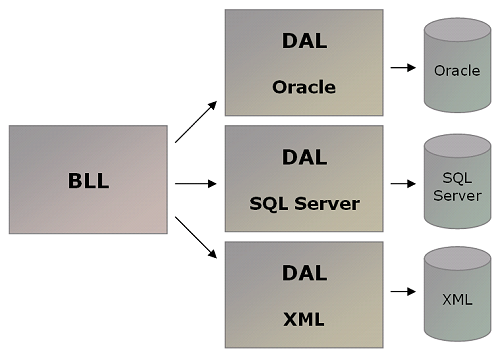
In
order to guarantee that BLL and DALs stay independent, an abstraction
mechanism must be used. This mechanism is described by the Factory
pattern.
The
Factory
design pattern provides an interface to create object instances
without specifying their concrete implementation classes.
This
pattern allows the BLL to manipulate IDalInvoice objects coming from
the DAL without depending on a specific DAL implementation. Here is
how the Invoice DAL would be designed:
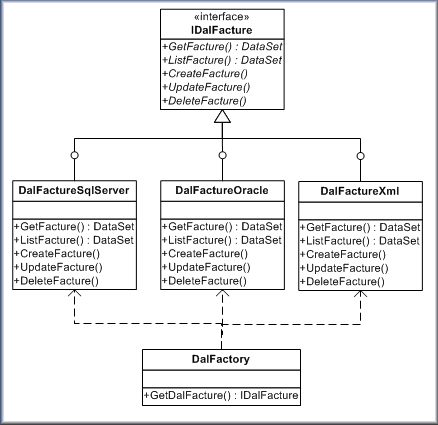
The
BLL layer would only have to use the DalFactory in order to get a
specific DAL implementation and hence manipulate this implementation
through the IDalInvoice interface.
SOA, evolution or revolution?
OOP versus SOA
There are two philosophies: the Object-Oriented
one and the Service-Oriented one. Maybe you already belong to the
second one. Maybe you are an Object ayatollah. Of course, we are
interested in the service oriented approach in this article but it is
good to know where lie the differences. This is a recurring question,
so let's have a quick look to both approaches so that you can
recognize which one you belong to.
Object-Oriented model (OOP)
Here is a three tier typical architecture with an
object model:
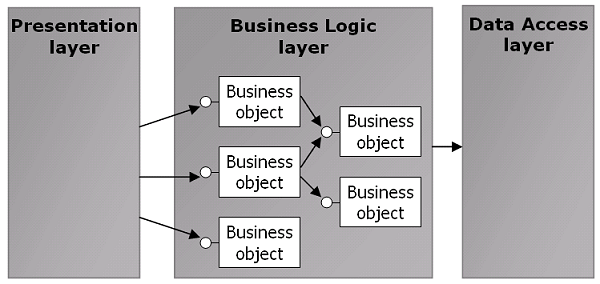
We can notice the dependencies between the
presentation layer and the business objects. The client code must
interact with the object model of the business layer, which increases
the coupling and requires an important amount of calls between those
layers. You'll understand that such an amount of methods invocations
between layers is a problem when business objects are located on a
remote machine. Likewise, the amount of business objects that the
presentation layer has to manipulate reduces the independence between
the layers and makes it difficult to learn how to use the business
layer.
Code sample:
Customers customers = Customer.List();
Orders orders =
customers[0].Orders;
Order order =
orders.Add("ORDER001", customerData.Customers[0]);
order.Lines.Add(new
Product("53XYPR0D8"), 2);
orders.Save(); // If the update
hasn't been done in real-time
We
interact with the the Customer ,
Order and Product business objects. We ask here to the
Order business object to take our modifications into account.
In some models, updates are directly executed on every call to the
business objects. Calls to the server are emphasized by bold
characters.
Service oriented model (SOA)
Here is a service oriented architecture that would
rely on the same business objects:
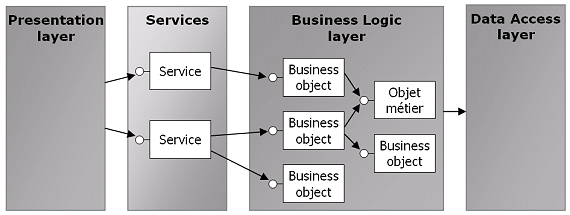
You'll have noticed that we introduced a new
abstraction layer called “Services” .
The Presentation layer doesn't directly manipulate the business
objects any more, but uses the services to access them. Business
objects are located in class libraries that the services load into
memory – since the service layer and the business layer are now
located in the same process, method invocations on our business
objects don't suffer any overhead.
Services behave as black boxes: they give an
abstraction of the object model and only expose a reduced set of
features, which reduces the interchanges between layers.
Code sample:
CustomerData customerData =
CustomerService.ListCustomers();
OrderData orderData =
new OrderData();
OrderEntity order =
orderData.Orders.Add("ORDER001",
customerData.Customers[0].CustomerID));
order.Lines.Add("53XYPR0D8",
2);
CustomerService.AddOrders(orderData);
The CustomerService plays with data objects
such as CustomerData and OrderData. Clients prepare
data objects and send them in one call. Now it's up to the service to
implement updates. This approach reduces the amount of calls to the
server and groups data: methods granularity has increased.
Friends or enemies?
As we have seen, the “full object”
approach has its limits. Contrary to what we could have expected,
those limits also include reuse. In the “full object”
model, the layers are coupled one to another. When we reduce this
coupling and reduce the dependencies by eliminating direct calls
between objects of different layers, our modules become easier to
reuse.
In the object model, the different layers are also
coupled in time , during the
whole life cycle of objects. We can consider that an object that is
created and returned by a lower level layer stays alive as long as it
is used by the upper level layer. This mustn't be the case in a
service oriented architecture, where inter-modules calls must support
asynchronous and / or disconnected modes. However, object don't loose
their value. But Object-Oriented programming and Design Patterns will
only be used inside each responsiblity layer.
Rumor: SOA
implies the death of OOP.
At least it is a
message Don Box
spreads (Don Box is the architect of Indigo). Unless it is due to
some journalist who wanted a pushy title... When we read articles
whose title says “Don Box from Microsof says SOA paradigms will
eclipse object-oriented programming”, we understand where the
trouble can come from. But let's clarify the situation: this is not
true, SOA won't replace OOP. May it be a journalistic deformation or
an awkward declaration from Don Box, it's time to dispel the fears
and to be objective.
To contrast OOP and SOA
is a bit like saying that OOP will be eclipsed by AOP (Aspect
Oriented Programming). The least we can expect from someone having a
professional integrity is to avoid excesses like “that's it, I
discovered the new technology that will replace everything else!”.
But I digress...
Moreover, we could even
think of SOA as being a come back to pure Object-Oriented
Programming. Do you remember objects theory? Objects exchanging
messages and calling one another? These ideas have been left aside at
least in C++, Java and .NET. Well, maybe SOA will bring them back
into fashion.
Complexity
Rumor: in
SOA, business modules communicate by exchanging messages.
Well, I think we can
design an SOA without any message and apply most of the SOA concepts
anyway. Once again, you don't have to throw everything away nor to
start again from scratch.
Rumor: we
cannot speak about SOA without business processes, orchestration and
transactions.
Do
you really think your applications have become so complex overnight?
Do you really need to consider all those problems, to use all those
standards and learn all those programs today?
What's your situation today?
If
you don't respect the SOA precepts, your applications are doomed to a
tragic fate, your architects will burn in hell and your project
managers will be sentenced to hard labor to reimburse the huge losses
your company will soon accumulate. No, let's be serious, you have
your time, and maybe you already are an unaware pioneer of SOA.
If
you base your development on an approach close to Duwamish Books 7,
you're on the right track. Duwamish is a sample application proposed
by Microsoft. The .NET version is released with VisualStudio.NET.
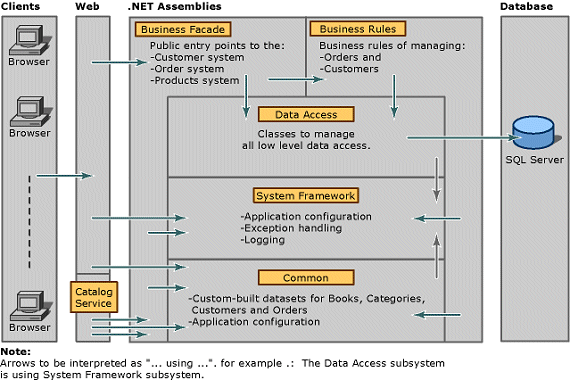
Duwamish
design is a bit old fashion, but it already introduced some concerns
we find back in SOA. You'll notice the separation into layers, and
above all the use of DataSets to transfer data between layers.
DataSets introduce data objects (business entities) which are
serializable into XML and disconnected from the data source.
Here
is a simplified diagram that sums up the design of a .NET application
that integrates the classical separation of concerns into layers and
SOA:
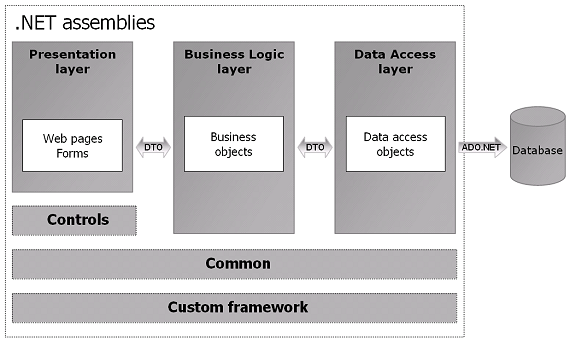
What
we can notice in this diagram:
Layers aren't tightly coupled one to another
Layers exchange Data Transfer Objects (DTO)
Communications are terse, but messages can be bigger than in a pure
object approach.
The Common module (or assembly) contains classes shared by all the
other layers such as data objects. Of course, this can only be true
if all the layers are implemented using the same technology.
The whole development lies on a hand-made framework, not only on
.NET or J2EE.
The Controls library contains graphical components used by the
Presentation layer.
As
you can see if you compare diagrams, SOA can be progressively
introduced since it isn't completely opposed to existing applications
architectures.
Keywords, definitions and rules
Uncoupling
Uncoupling
is the fundamental concept of SOA. We'll find it in many occasions.
For example, here are three aims of SOA where uncoupling appears:
to reduce the coupling between modules (to reach a better
reuse)
to
reduce the coupling towards the platform and
infrastructure (for a better
interoperability)
to reduce the coupling between the client of a service and a
specific implementation of this service (for a better
flexibility)
Service
The
keyword in Service-Oriented Architecture is of course “Service”.
It isn't so easy to define the concept of “service” even
if many persons already tried it. I'll humbly propose my own
definition:
“A
service is a module that can be invoked, that is assigned to a
specific function and that offers a well defined interface”.
For
example, you can draw a relationship with the different services a
hospital provides.
It
is important to understand that the “service” concept has
a broader meaning than a simple “WebService”. We can do
SOA without WebServices and reciprocally to implement WebServices
doesn't mean we do SOA. WebServices propose one technical solution to
implement SOA, the same way message queuing can do for example.
There
are many kinds of services. A service can be local or remote.
Examples: a service available via SOAP and WSDL on the Internet, a
database, a directory...
A
service is created in the context of an application (it is rare to
publish services without any reason) but has to be designed so that
it can be reused in other contexts. Hence, we'll try to forecast the
future uses of a service and the associated constraints. Similarly,
services must be designed so that they can be used both locally and
remotely. A late adaptation to remoting would require a significant
amount of work. Respecting design rules such as the Facade or
the Data Objects greatly facilitates an evolution to remote
applications.
Of
course, applications and services will behave differently in
different contexts. For example, a service that has been optimized
for remote calls won't be optimal for local calls, and reciprocally.
However, it is possible to be compatible with both usage modes. For
example, if methods signatures are proposed in two versions (one that
optimizes calls when they are made in the same process, the other
that allows to physically distribute layers), it is possible to
switch from local to remote mode without changing the code.
For
example, we could call void ListCustomers(DataSet) locally and
DataSet ListCustomers() remotely. The first version enables
the Presentation layer to pass a DataSet to be filled. This doesn't
fit well with remote invocations since it would imply many
inter-process or inter-machine calls. Hence, the second version
returns a DataSet that will have been created and filled by the
ListCustomers() method of our service, and then serialized to
the client.
Factorization
A
service must play a unique and well defined role. In the following
diagrams, we present the situation when a service needs to
authenticate the caller.
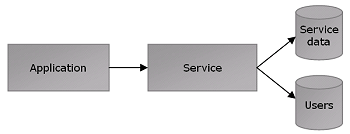
A
service that implements authentication
It
would be better to isolate the authentication outside the service. In
fact, this feature should become a service by itself.
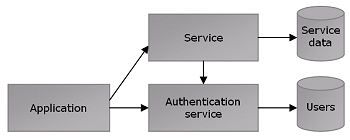
After
the authentication has been externalized
This
way, the service only has a business role and relies on another
service whose business role is to authenticate users. The added value
of this factorization is that yet another service will be able to
take advantage of the authentication service. It also avoids to
duplicate authentication code in each service. Hence, we respect the
DRY principle (Don't Repeat Yourself): “
Every
piece of knowledge must have a single, unambiguous, authoritative
representation within a system”.
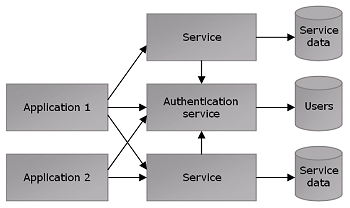
This
reasoning will also help us to implement a Single Sign On (SSO)
mechanism. Yet another evidence that this operation was well-founded.
Facade
Modules must be designed from an outside point of
view: designers should take the point of view of a user of the module
that is designed. What will be exposed to the user of this module is
called a facade or the service interface, which
has to be opposed to the implementation that contains the processing
code.

A
business module cut off
Usage
simplification
-> Simplify the interface of your business
modules.
It is very important to simplify the interface our
modules publish to the outside world. We must provide users with a
public interface that doesn't force them to manipulate objects
directly. That's why we have to use a facade.
Service contract
->
Our modules interfaces represent a business contract
The
second aim is to separate the contract from its implementation. This
allows to change implementation without breaking the contract. The
same interface can be shared by many implementations. Services can be
switched without problem.
The
join point between the service and its consumers is the facade. In
this situation, it becomes easier to replace a service by an
equivalent one since the biggest difficulty is to establish the join
between service providers and consumers.
Facade model
The Facade
design pattern simplifies and unifies the interface of a coherent and
possibly autonomous sub-system. A facade is a simplified entry point
of an API, which makes a set of classes easier to use.
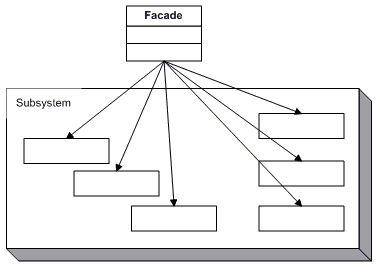
To
implement the facade, the only thing to do is to group all the
features a business module proposes and to expose this group as a
list of methods so that those methods aren't spread over many
classes.
Recommendation: define modules facades
before implementing them
It is all the more simple since a facade can be
defined from UML use cases. Behaviors that are functionally
close will be gathered in a facade (that can play with many business
objects). Anyway, when you define use cases, do you think about
business objects or behaviors (services invoked by users)?
Nice side effect: Martin Fowler uses the
word “Remote
Facade” which implies that the facade model is good for
distribution. By increasing the granularity, we reduce the round
trips and hence increase performances.
Facade samples
Here are the methods we could put in the
CustomerService facade:
CustomerData ListCustomers()
CustomerData
ListCustomers(filter)
CustomerData
GetCustomer(customerID)
void
AddCustomers(CustomerData data)
void
DeleteCustomer(customerID)
...
...
and in the OrderService facade:
OrderData ListOrders(customerID)
OrderData
GetOrder(orderID)
void
AddOrders(OrderData data)
void
DeleteOrder(orderID)
...
Data Objects
Data
objects only contain data, no business logic. They can be thought of
as simple data structures that vehicle data from one layer to
another. Of course, this strict definition can (should?) be adapted
in some situation. We'll sometimes allow us to associate a minimal
behaviors to those objects.
Data
Objects must respect some rules such as:
They
must be serializable into XML
They
must be independent of any implementation platform (A Data
Object coming from a service that is implemented in Java must be
consumable from a .NET application for example. XML serialization
guarantees this point. In this example, both side have an object,
respectively in .NET for the client and in Java for the service,
that is the incarnation of the same XML schema).
They
must be independent of the data source. The best way to make
sure that this point is respected is not to include any persistence
code in the Data Objects.
Data
Objects have many synonyms, such as Business Entity, Value Object or
Data Transfer Object (DTO). The last one has the advantage to
explicit the fact that such an object only contain an aggregation of
data to be transfered, and not business logic.
The
.NET DataSet is an object that respects those rules, that's why it is
recommended. But scalar types such as integers, decimals, dates or
strings aren't excluded. Any ValueType such as structures or
enumerations are also valid. A last remark: be cautious with DataSets
since their default serialization scheme make them difficult to use
in J2EE. We have to choose an XML format that doesn't couple us to
any specific platform.
Data Object sample
Here
is what the OrderData object can look like:
1 OrderHeader (OrderNo, CustID,
OrderDate, ShipDate)
1 Customer (CustID,
Name)
1..n Line (ProductID, Quantity)
Such
an object can retrieve all the data an order contains in one call.
Hence, we avoid to split our invocations into one for the header, one
for client infos, and one to get the order lines. A method that would
send back this data object could be: OrderData GetOrder(orderId)
.
SOA doesn't go along with Object-Relational mapping tools
One last note to warn you about Object-Relational
mapping frameworks that don't allow you to serialize data into XML.
They are plenty, and often not adapted to service oriented
architectures. Object-Relational mapping tools often take for granted
that the entities you manipulate are linked to data sources that are
updated when objects are modified. In SOA, the persistence
responsibility falls to a specific layer – persistence code is
certainly not located in the entity itself.
Try to ask yourself these questions by the way:
Can I save my data objects into different
formats?
Do I master the method invocations that are
made to support persistence? Are those calls frequent? When do they
occur?
Is it possible to reuse my data objects in
another platform? Without the object-relational mapping tool?
Are my business object going to directly
connect to the database???
What happens when I distribute my
presentation layer or the clients of my service?
To go further
Some people may find that I gave an unconventional
and simplistic view of SOA. Well, this will only make me proud since
my aim was to avoid the complexity SOA may impose to us.
On purpose, I let aside asynchronous invocations,
disconnected mode, transactions, business processes, service
orchestration and security in order not to make the message too
complex. These points shouldn't be neglected, but it is possible to
consider them later, without making our developments 100% SOA
compatible right from the start. However, I invite you to consider
these features at least to know where we are going to, and to keep in
mind the constraints you may have to take into account in the future.
For example, applications should be designed so that they can work in
an asynchronous or disconnected mode even if it is not the case for
now.
Here are some topics you can examine to go
further:
Shadowfax, that will become the new
reference application from Microsoft. It aims at showing how an SOA
solution can be set up right now.
Indigo, the WebServices-based
inter-application communication infrastructure that will be
integrated into Windows Longhorn (a version will be released for
Windows XP and Windows 2003 as well)... but that you won't deploy
before some years from now... Keep a distant eye on it anyway...
Things about BPM (Business Process
Management) and BPEL (Business Process Execution Language)
Biztalk and equivalent products to
orchestrate Business Processes
Epilogue
As
a conclusion, I invite you not to hesitate to adapt SOA to your
applications real constraints (not the opposite). Theories are here
to guide us, not to restrain us.

Who
is Fabrice Marguerie?
Fabrice
Marguerie is a .NET architect for Masterline. Fabrice works as a
consultant on design and implementation missions. He has created and
developed Masterline's .NET framework. He also writes a weblog in
English: http://weblogs.asp.net/fmarguerie
and
administrates the web site: http://sharptoolbox.com
His
company: Masterline
Founded
in 1989, Masterline is a service and consultancy company which mainly
targets three markets: business intelligence, e-business and SAP.
Masterline proposes technology consultancy, engineering and
externalization services whose first aim is to create value for its
clients. Masterline builts its competences (.NET, Java, Object and
UML...) around dedicated competence centers and is a Microsoft
partner since 1994.

Translator
(French to English): Thomas
GIL
Copyright
DotNetGuru January 2004
Resources
Shadowfax:
http://workspaces.gotdotnet.com/shadowfx
PetshopSOA:
http://dotnetguru.org/article.php?sid=286
Duwamish: Documentation
– Powerpoint
slides
Udi Dahan weblog :
http://udidahan.weblogs.us/archives/012683.html
- I'll see you when you get there
http://udidahan.weblogs.us/archives/012770.html
- But that trick never works
15 seconds - Realizing a Service-Oriented
Architecture with .NET: a simple and efficient web service
oriented introduction http://www.15seconds.com/issue/031215.htm
The Pragmatic Programmer : if it is not yet
your bedside book, go and get it right now! To read again and again.
The fifth chapter "Bend, or Break" speaks about SOA while
the word didn't exist yet. The authors also have a web site:
http://www.pragmaticprogrammer.com/
Comments are welcome














